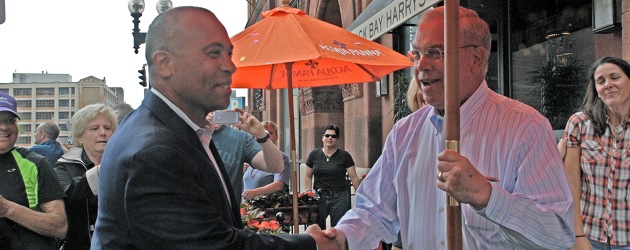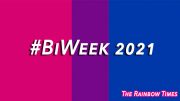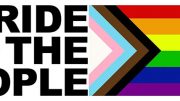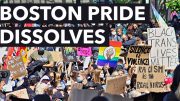
At the 2014 Boston Pride Parade, Governor Deval Patrick greets former Boston Mayor Thomas M. Menino, a moment shared with TRT. MORE PHOTOS of the Parade and Festival here.
Photo: Christa April Lamb of North Andover, MA
By: Lauren Walleser/TRT Assistant Editor—
BOSTON, Mass.—The 44th annual Boston Pride Parade kicked off Saturday, June 14 with Mayor Martin J. Walsh cutting the ribbon over a rainbow-painted crosswalk near Copley Square. The parade, led by Grand Marshals Governor Deval Patrick and the Boston Sisters of Perpetual Indulgence, along with approximately 25,000 marchers, made its way through the rain towards City Hall Plaza, where the Boston Pride Festival hosted vendors, entertainment, and LGBTQ organizations of every kind.
Libby Bouvier, board member and archivist for The History Project, spoke of how the festivities have changed over the years, from a march and rally to a parade and festival.
“The community has grown incredibly in numbers and in just every imaginable way,” Bouvier said. “We always want to be able to preserve the history of the LGBT queer community of Boston and Massachusetts.” [pullquote]“The community has grown incredibly in numbers and in just every imaginable way,” Bouvier said. “We always want to be able to preserve the history of the LGBT queer community of Boston and Massachusetts.”[/pullquote]
According to Bouvier, a purple, paper mache rhinoceros with a heart led the first pride marches in the 70s, which began at Jacques Cabaret in Boston, went on to the police station on Berkeley and Stanhope, to the state house and St. Paul’s Cathedral, before ending up at The Parkman Bandstand on Boston Common. At each stop, a prepared speech that was given by one of the coordinators of the march, talking about the lack of fair treatment by police, discriminatory laws, homophobia in churches, and various other issues affecting LGBTQ people.
“We think Pride is important because it’s a great time for people to come together,” said Johannes Wilson, a member of Black and Pink, and organization supporting LGBTQ prisoners and working to abolish prisons. “It has an awesome, radical history, where it started with the Stonewall Riots, which was led by trans women fighting against policing, and the Pride march used to go outside of prisons and rally to support incarcerated people, so we want to bring some of that spirit back.”
While Pride has certainly changed, this year’s parade and festival still brought together a variety of causes, from social justice organizations to religious and spiritual groups, political campaigns and nonprofits, along with major corporations, vendors and retail chains. Over 220 groups were scheduled to march in the parade, and over 130 organizations were registered to participate in this year’s festival.
“Historically, the pro-choice movement and the LGBTQ movement have so much in common, and we’re often fighting for similar initiatives, whether it’s recognition of our sexuality as something that we can express, to the right to make decisions about our bodies that other people want to regulate,” said Hailey Magee, intern and campaigns coordinator at NARAL Pro Choice Massachusetts. “We really want to come together and show that our movements stand in solidarity with each other. That’s why we’re here.”
Peggy Hayes, vice president of Dignity Boston, an organization of gay, lesbian bisexual and transgender Catholics and allies, said her congregation has been in Boston for more than 40 years, operating independently from the institutional church and countering its anti-LGBT teaching.
“I love the variety and the diversity [at Pride], from the two-year-old in the stroller to the 90-year-old,” Hayes said. “It’s our holiday, and more and more I actually have straight friends who feel like it’s their holiday too because it’s so inclusive.”
Ellyn Ruthstrom, president of the Bisexual Resource Center (BRC) and executive director of Speak Out, shared why it is important for her organizations to be represented at Pride.
“We are the B in LGBT,” said Ruthstrom, speaking of the BRC. “We have so many people come up to the table that are so happy to see us. They’re like ‘Oh my God, you’re the only bi presence here,’ and they are just so happy to connect with our community.” [pullquote]“We are the B in LGBT,” said Ruthstrom, speaking of the BRC. “We have so many people come up to the table that are so happy to see us. They’re like ‘Oh my God, you’re the only bi presence here,’ and they are just so happy to connect with our community.”[/pullquote]
Jill*, director of outreach for the New England Leather Alliance (NELA), also spoke to the importance of visibility. NELA specializes in outreach, advocacy and education for the kink, BDSM and leather communities.
“I think there’s a lot of negative stereotypes associated with BDSM that have been perpetuated by various books and images in the media,” Jill said. “It’s important that we’re out here so people can see that we’re regular people who just enjoy activities that are a little bit different between consenting adults.”
Jack Lewis, executive director of The West Suburban Alliance of Gay, Lesbian, Bisexual, Transgender, and Queer Youth (WAGLY), one of the many youth organizations present at Pride, said their main goal was to let youth know there is a safe place for them to meet.
“WAGLY has a booth at Pride each year not only to make sure the community knows we exist and so we can network with other organizations, but also so that youth, our primary group that we’re focused on meeting needs for, knows that we have services, especially in areas like Metro West Boston, where there aren’t a lot of things for GLBT people, and really outside of high schools nothing for GLBT youth other than the programs we offer,” said Lewis.
Other organizations, like the Department of Veterans Affairs, were there to help adults find the services and benefits they may need.
“I’m getting feedback from some of the guys and gals that are coming here that they actually got kicked out of the service because of their affiliation, and we want to let them know that our services are here and they might qualify regardless of whether they only did a short period of time,” said Deborah Outing, outreach coordinator for the Veterans Health Administration in Bedford, Mass. “They need to know that our services are available for them as well. We do support the LGBT Veterans community.
Performances on the main stage kept the party going throughout the day, from local singers, drag artists, and same-sex ballroom dancers, to headliners Jeanie Tracy, JD Samson, Alex Newell, and A Great Big World.
The Rainbow Times was Boston Pride 2014 Official media partner. Please check out the photo coverage of ALL of Boston Pride 2014 events here!
For more information, visit www.bostonpride.org.
*Jill chose not to share a last name.







